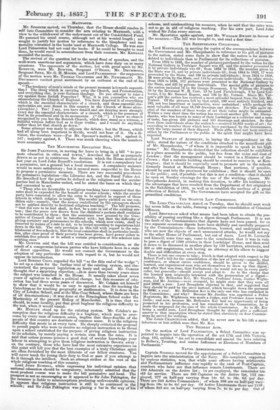Tun Siremesnalexs COLLECTION.
Lord Moisreacim, in moving for copies of the correspondence between the Government and Mr. Sheepshanks in reference to his gift of pictures to the nation, stated some facts to show that the nation is far more indebted to individuals than to Parliament for its collections of pictures.
From 1824 to 1833, the number of pictures purchased by the nation for the National Gallery in Trafalgar Square was 42, and the number presented to it by private individuals was 68; from 1834 to 1843, the number given by the State was 15, and by private individuals 63; from 1844-to 1853, 17 were presented by the State, and 188 by private individuals ; from 1854 to 1856, 38 were given by the State, and 114 by private individuals. In other words, from 1824 to 1856, 112 pictures were presented to the National Gallery by the State, and 433 by private individuals. The special gifts of pictures to the nation included 16 by Sir George Beaumont, 6 by William the Fourth, 35 by the Reverend W. H. Carr, 15 by Lord Farnborough, 8 by Lord Colborne' 3 by Mr. Samuel Rogers, and 156 by Mr. Vernon. Since Mr. Vernon's gift the nation has received a most splendid bequest from the late Mr. Turner. Of the pictures left by that artist, 100 were entirely finished, and 182, not leas important or instructive, were unfinished ; while perhaps the most valuable of all were 18,749 drawings and sketches. For this inere recital of the numbers of these works of art their value might be estimated. Within a very short time the nation has received another gift. Mr. Sheepshanks, who was known to many of their Lordships as a collector and a man of taste, has given 233 pictures and 103 drawings and sketches. So that from these individuals alone the nation h:ts received 19,823 works of art ; far exceeding in number those which have been purchased by the Government, with the large means at their disposal. These gifts have not been received either by the Parliament or the public in the spirit that might have been expected. Lord STANLEY of ALDERLEY, in laying the correspondence on thetable
, stated the nature of the conditions attached to the munificent gift of Mr. Sheepshanks, " of whom it is impossible to speak in too high terms." Mr. Sheepshanks desired that the collection should be exhibited in a place accessible to the public, but free from the noise and dust of London ; that the management should be vested in a Minister of the Crown ; that a suitable building should be erected to receive it, at Kensington; that it should be especially used to promote art in the schools formerly located at Marlborough House ; that portions, if possible, should be sent into the provinces for exhibition ; that it should be open to the public ; and, if possible—but this is not a condition—that it should be open on Sunday evenings for the use of the working classes. Mr. Sheepshanks desired, in making this donation, to offer his testimony to the advantages that have resulted from the Department of Art originated in the Exhibition of 1851, as well as to establish the nucleus of a great collection of British art. The Government have accepted the gift on the prescribed conditions.


























 Previous page
Previous page